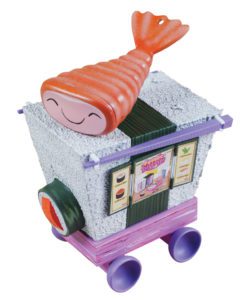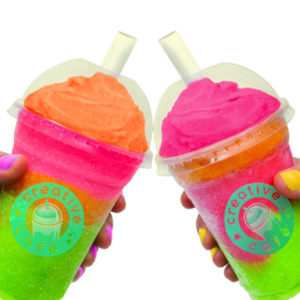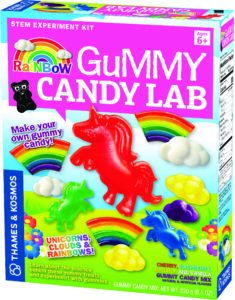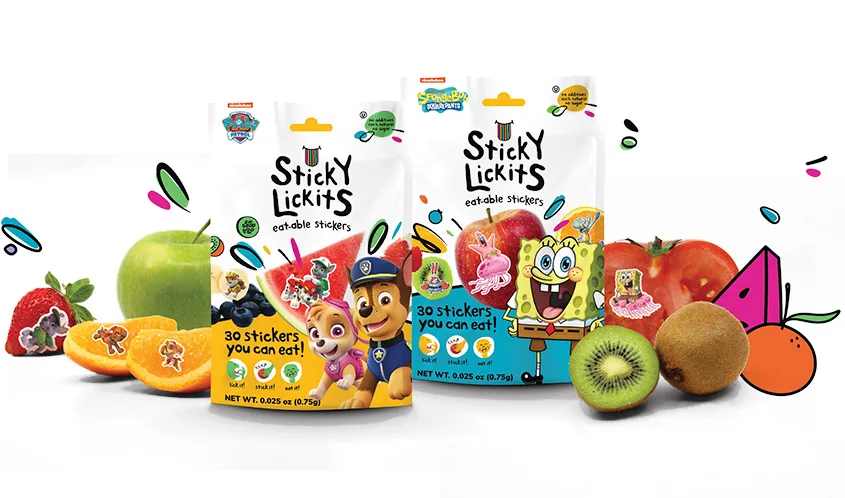The toy industry embraces foodie fun with edible toys.
By JACQUELINE CUCCO, associate editor
Elbows off the table, napkin in your lap, and don’t play with your food! Adults have always taught kids that food is for eating, not for playing. But toymakers are taking matters into their own hands and flipping the switch on the age-old rules of etiquette with a whole buffet of edible toys on the market. That’s right — toys you can eat.
NEW TREND ALERT
One of The Toy Association’s top toy trends of this year is “Foodie Fun,” based on the creative ways that food and drink items are making their way into the toy aisle. “We absolutely see this as a growing trend and saw a lot of fantastic edible food toys at Toy Fair New York,” says Adrienne Appell, The Toy Association’s senior director of strategic communications. “Some of these toys teach kids about cooking and healthy eating habits, and others are really just about being experimental and having tons of fun while making tasty treats.”
Food-related toys are not a new idea (remember the Easy-Bake Oven?), but manufacturers are staying ahead of the curve with what’s trendy for today’s kids. “We are already seeing great innovation in the area,” Appell says. “A lot of these toys produce truly delicious food and tap into foodie trends, from Instagram-worthy eats to trendy desserts.”
BUFFET OF TOYS
RedwoodVentures is venturing into edible toys for the first time with Foodie Surprise, mini mystery food carts that contain surprise ingredients and supplies for kids to make their own edible candy. The food carts come in a variety of themes, such as sushi, pizza, and ice cream, so kids can partake in DIY fun to make edible gummies that are colored and shaped like different foods. Then, kids can pack the snacks inside collectible “to-go container” keychains to save them for later.

“It hits on a number of key trends, including DIY, foodie culture, carts and trucks, of course, and a consumable candy line that will be merchandised in the collectible toy space for the first time ever,” says RedwoodVentures CEO Andy Wiseman. He also revealed that RedwoodVentures is opening a candy division in the fall as opportunities continue to expand with “interest from sectors of retail that are new to us, like candy and confectionery.”
That element of discovery and experimentation makes it fun for kids. “Foodie surprise is a blind purchase brand, but in addition to that, the candy making experience is very engaging for kids, and adds another layer of fun discovery,” says Wiseman.
Kids may not be old enough to caffeinate with an icy frappuccino, but they can make their own version of the frozen beverage this summer with Mattel’s RoseArt Creative Café Frappe Maker. It comes with apple-, mango-, and strawberry-cream-flavored powders that kids can mix with milk or a milk substitute to create a blended drink.

The Yummy Nummies collection, from Blip Toys, has a variety of kits, including a Soda Shoppe Maker, a Cake Push Pops Maker, a Sweet Straws Maker, a Marshmallow Treats Maker, and the newest version, a Slushy Maker.
For kids who can’t get enough of the gross trend, Jakks Pacific is launching the Chocolate Poop Maker this fall. Kids can melt chocolate, flush it down the toilet-shaped dispenser into the poop molds, refrigerate it, and eat it. They can make brown chocolate for realistic-looking poop or pink chocolate for a more whimsical poop experience.
Thames & Kosmos has Candy Chemistry kits that teach kids hands-on science principles as they create different types of edible candy, such as gummies, chocolate, and hard candy. The newest addition, the Rainbow Gummy Candy Lab, features a gelatin mixture kids can use to personalize unicorn-, cloud-, and rainbow-shaped gummies while learning about the scientific properties of natural polymers.

“It’s a fun, yummy activity that sneaks in some science lessons as well,” says Andrew Quartin, CEO of Thames & Kosmos. “The idea of making your own candy is very appealing to kids, while the educational factor appeals to parents.”
There’s a fair amount of customization that goes into making the candy. Kids can choose which flavors they want to make, which colors they want to use, and which molds to use to shape the gummies. They can even add citric acid to turn the gummies sour. “It’s also important to us that we continue to offer enriching scientific content with each kit,” Quartin says. “Our goal is to continue to make science relatable and fun for kids.”
NUTRITION AMBITION
Parents who are concerned about nutrition don’t need to worry; not all edible toys revolve around sweets and candy. Linda York launched StickyLickits last October as a way to encourage her grandkids to eat healthier snacks. StickyLickits are edible stickers that kids can stick on food and then eat. The non-GMO, vegan, and kosher stickers are free of sugar, peanuts, tree nuts, gluten, soy, and dairy. To use them, kids peel a sticker off the backing, lick it, and stick it on fruits, veggies, or anything edible. They have a slight marshmallow taste when you eat them on their own, but when you stick them on food, they basically take on the taste of the fruit or vegetable. StickyLickits melt in your mouth and are meant to promote healthy eating habits.
“Kids love stickers. They love peeling them off the backing and they love the satisfaction of placing them on something and having them stick,” says York, CEO of StickyLickits. “Studies from the Cornell Food Lab have shown that a child will choose a piece of fruit with a paper sticker of a favorite animated character on it over a sweet dessert, so the opportunity was there to make edible stickers.”
SitckyLickits are available online at stickylickits.com in several themes, including SpongeBob SquarePants, Paw Patrol, and StickyLickits originals featuring silly faces and fun doodles. Each pack contains 30 unique, edible stickers for $4.99.
SAFETY FIRST
Because kids are ingesting the toys, do parents need to worry more about safety? In short, no, not if it’s from a trusted brand.
“Consumer Product Safety Commission (CPSC) testing does a great job covering this, and parents need to look for those labels,” says Christine Osborne, founder of specialty toy store chain Wonder Works. All toys designed for kids ages 12 or younger are subject to a set of federal safety rules and still need to pass the CPSC’s standards. The Toy Association’s Adrienne Appell says, “As with all toys, parents should follow the age grading on the toy box, read all instructions carefully, and teach their kids how to properly and safely use the toy.”
Whether kids are more of an Alton Brown or a Duff Goldman, a Rachael Ray or a Giada De Laurentiis, there are so many different recipes for them to spice up their toy rooms this year. And the next time someone lectures you on playing with your food, or your toys for that matter, you can tell them to eat it.
This article was originally published in the March/April 2019 issue of the Toy Book.

